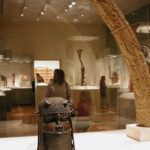There were many famous blacks who were born or lived in Alabama who made their mark on the nation and the world. Alabama was also a major battleground for many of the events that occurred during the Civil Rights Movement. The state has a wealth of museums and attractions that highlight famous black Alabamians, events, and black historic sites. This list provides ten of the many black historic sites and points of interest in the state.
Birmingham Civil Rights District, Birmingham –This downtown area of Birmingham includes the Birmingham Civil Rights Institute, a museum that features permanent exhibits, special exhibitions, and galleries that highlight the civil rights struggles that occurred in Birmingham and the South. Across from the street from the museum is the 16th Street Baptist Church, the site where four young black girls were killed by a bomb. The bombing galvanized the civil rights movement and was instrumental in garnering support for the 1964 Civil Rights Act. The church and the museum both face Kelly Ingram Park, the site of civil rights protests. Demonstrators were attacked by police dogs and sprayed them with high powered water hoses. The events that occurred in Kelly Ingram Park provided some of the most memorable images of the civil rights movement. The park has statues and sculptures that recount the activities that occurred during the protests. The district also includes the Carver Theater, A. G. Gaston Motel and many other places that were at the center of black life in the Birmingham. The district is located near the intersections of 16th Street and 6th Avenue North.
Tuskegee Airmen National Historic Site, Tuskegee – This National Park Service site was the location of training for the black airmen during World War II. The site has exhibits and shows historic films that depict the stories of the Tuskegee Airmen. The black pilots trained at Tuskegee were some of the most highly respected group of fighters that served in World War II. The Tuskegee Airmen National Historic Site is located off I-85 between Atlanta and Montgomery and is adjacent to Moton Field.
Tuskegee Institute National Historic Site, Tuskegee – Another great place to visit while in Tuskegee in the Tuskegee Institute National Historic Site which is on the campus of Tuskegee University. It features the George Washington Carver Museum and The Oaks, the home of the first Tuskegee Institute President, Booker T. Washington. The Carver Museum features specimens, products, and crafts for the famous inventor and scientist, George Washington Carver, who was an instructor at Tuskegee Institute. Many of the products that Carver developed from peanuts and other plants such as sweet potatoes can be found here. The Oaks, now a museum and park of the National Park Service, was the social center of Tuskegee Institute and Washington entertained such notables as President Theodore Roosevelt, Andrew Carnegie, and William Howard Taft. The house features furnishings built by the local craftsmen and Tuskegee students. And it has friezes in the parlor and library depicting the European trip made by Washington and his wife. The Tuskegee Institute National Historic Site and Tuskegee University is near downtown Tuskegee.
Civil Rights Memorial and Center, Montgomery – The Civil Rights Memorial is a memorial dedicated to the memory of those killed during the Civil Rights movement. Created by the designer of the Vietnam Veterans Memorial, Maya Lin, the black granite memorial is located in an open plaza adjacent to the Southern Poverty Law Center and it is accessible 24 hours a day. The Civil Rights Memorial Center is adjacent to Memorial and provides exhibits and in-depth information about the martyrs of the Civil Rights Movement. It also has the Wall of Tolerance, classroom, theater, and a section focused on contemporary social justice. There are guided tours available of the center and admission is $2 for adults and free for children under 18. The Memorial and Center is located at the corner of Washington Avenue and Hull Street in downtown Montgomery.
Dexter Avenue King Memorial Baptist Church, Montgomery – Just around the corner from the Civil Rights Memorial and located just blocks from the Alabama State Capitol building is the Dexter Avenue King Memorial Baptist Church. This is the church that Martin Luther King, Jr. was serving as pastor when the Montgomery Bus Boycott. The Bus Boycott helped spark the start of the modern Civil Rights Movement and launched King into national and worldwide prominence. The church is a National Historic Landmark and features a large mural that depicts Martin Luther King’s civil rights legacy from its beginnings in Montgomery until his tragic death in Memphis. There is also a Parsonage Museum that features the residence of former pastors such as King and Vernon Johns. The Parsonage Museum has the King-Johns Garden for Reflection and an Interpretive Center. The church still has regular services but is open to guided tours by request. Dexter Avenue King Memorial Baptist Church is located on Dexter Avenue at the corner of Decatur Street.
Rosa Parks Library and Museum, Montgomery – Located on the site of the old Empire Theater and on the present-day campus of Troy University at Montgomery, the Rosa Parks Museum highlights the legacy of the woman who sparked the Montgomery Bus Boycott and ultimately the beginning of the modern Civil Rights era. The museum features a reconstructed street corner, a film that introduces the story of the boycott, and other exhibits that puts the visitor back in the era of the boycott. The museum is part of the university’s campus library and there is also a new Children’s Wing, with exhibits geared especially towards children. The Rosa Parks Library and Museum is located at the corners of Molton and Montgomery Streets in downtown Montgomery.
National Voting Rights Museum and Brown Chapel African Methodist Episcopal Church, Selma – The National Voting Rights Museum captures the events and images from the Civil Rights Movement and especially the events that unfolded in Selma, Alabama. The museum is located at the foot of the Edmund Pettus Bridge in downtown Selma. The Edmund Pettus Bridge was the scene of the horrific beatings of marchers by police as they attempted to march to Montgomery. Several blocks away is the Brown Chapel African Methodist Episcopal Church which was the site of meetings and starting point of the Selma to Montgomery marches. Located in front of the church is a monument dedicated to Dr. Martin Luther King, Jr. The church is located just east of downtown Selma. The Edmund Pettus Bridge is another site to visit and cross while in Selma. The bridge is located on U.S. 80 as it crosses the Alabama River in downtown Selma and is adjacent to the National Voting Rights Museum. The Edmund Pettus Bridge is also the starting point for the Selma to Montgomery National Voting Rights Trail.
The Selma to Montgomery National Voting Rights Trail, between Selma and Mongtomery – The trail is a 50 mile long historic route that the non-violent Civil Rights protestors marched in 1965 on their way to the state capitol in Montgomery. This road, U.S. Highway 80, leads from Selma to Montgomery and has several points of interest identified along the way. The Lowndes County Interpretive Center is the first of three proposed visitor centers along the trail that provides information about the events, people, and times of the Civil Rights movement. The highway is also designated as a National Scenic Byway/All-American Road.
W.C. Handy Birthplace, Museum, and Library, Florence – The city of Florence is located in northwest Alabama and is the birthplace of W.C. Handy, often referred to as the “Father of the Blues.” The musician and composer was born in Florence in 1873, and was one of the most influential musicians and songwriters of his time. His home has been completed restored and highlights many of his personal items, music manuscripts, library, and other memorabilia. It also includes his piano and trumpet. The museum is located on West College Street, just west of downtown Florence.
TalladegaCollege, Talladega– The oldest historically black college in Alabama, established in 1867, Talladega College has three buildings on its campus that have been declared National Historic Landmarks or Places. Among them is Slavery Library, known for the Amistad Murals. The Amistad Murals commemorate the Amistad Incident, with murals on the walls and on the floor. The library also contains a collection of Nigerian and Angolan artifacts. Talladega College is located near downtown Talladega and the city is about 12 miles off of I-20 between Birmingham and Atlanta.





